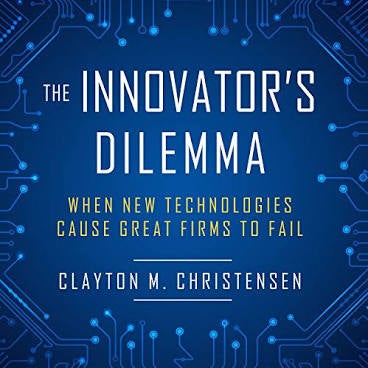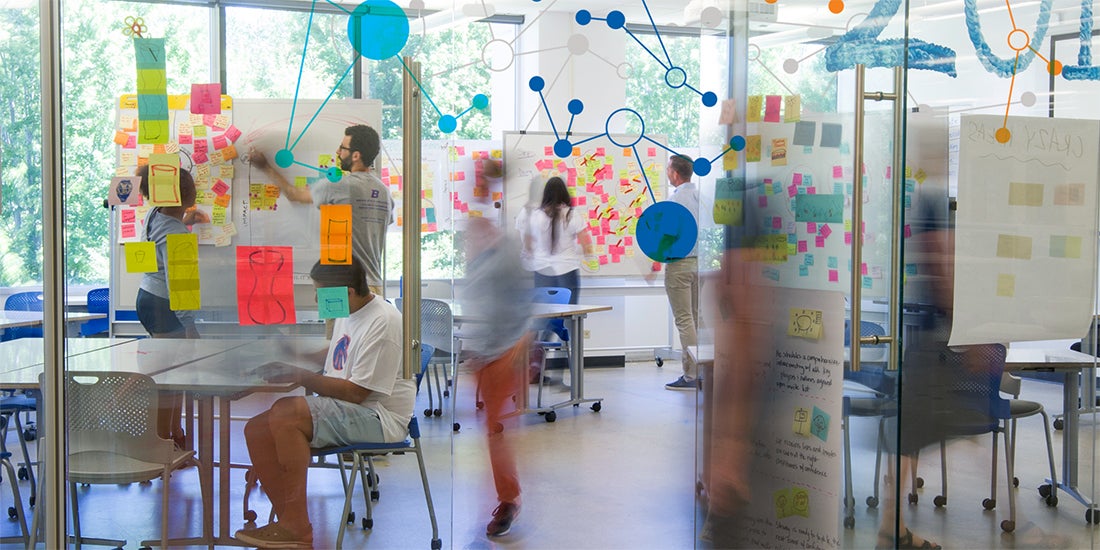
Shawn Benner is the Associate Dean in the College of Innovation and Design and the Director of the Human-Environment Systems Program. Prior to joining the College of Innovation and Design, Shawn was a professor in the Department of Geosciences at Boise State.
Harvard Business Professor Clayton Christensen, best known for his work on “disruptive innovation,” passed away on January 23. His passing offers us an opportunity to reconsider the bind in which American higher education finds itself. Faced with rising costs, declining societal support, uneven enrollments, and rapidly changing workforce needs, higher education—and especially state institutions—are under siege from a variety of quarters.
Christensen’s work encourages us to pay particular attention to the rising tide of disruptive innovators, both as a threat and as a source of inspiration. Higher Ed is not immune to challenges from these disruptors and Christensen can help us understand what this phenomenon may mean for the academy.

In his book The Innovator’s Dilemma: When New Technologies Cause Great Firms to Fail, Christensen lays out his most famous idea: real disruption to any industry usually comes from outside the existing sector. An outsider figures out some innovative way to provide a product or service much more cheaply and often in a radically different way. There are many interesting examples of this kind of disruption, but one we are all familiar with is the way that Netflix rapidly and radically altered the movie industry.
Indeed, as we saw with the early years of Netflix, the “product” the newcomer delivers is generally not very high quality. But consumers find it valuable, and the outsider quietly grows market share. When the established companies/organizations finally realize what is happening, their existing cultures and infrastructure hinder the needed pivot, and they are pushed to extinction. Other classic examples are how Kodak camera film was displaced by the arrival of digital photography, and how the record industry was disrupted by streaming music services.
The ideas that Christensen developed strongly influence the College of Innovation and Design at Boise State, where I work; they provide a sense of urgency to our day-to-day activities. We are laser-focused on improving access to Higher Ed for a broad swath of students, making education affordable, and ensuring our students are successful beyond graduation.

But we’re also keenly aware that disruptive innovators from outside of Higher Ed are always nipping at our heels.
In our academic world, the potential disruptive newcomers come in a variety of forms, but perhaps the most visible are the emerging mega-online universities like Western Governors, Southern New Hampshire and the online corporate versions like Coursera. They are using a radically different approach to education (online delivery) that is substantially cheaper. Like with the disruptive innovators we mentioned above, the “product” these universities provide may still be perceived as of lesser quality than an in-person, on-campus degree.
But it is apparently good enough.
These online, mega-universities are growing at double digit annual rates and are already some of the largest institutions in the United States. Here in Idaho, in-state student enrollment in our three traditional universities has been flat or declining over the last decade, despite increasing rates of high school graduation. In contrast, Idaho students enrolled in Western Governors has increased from a handful five years ago to over 2,000 students today.
Christensen famously, and perhaps prematurely, predicted that disruptive innovation in Higher Ed would result in thousands of universities failing across the country. That has not happened—at least not yet. Some folks have used the “failure” of Massively Open Online Courses (MOOCs) to rapidly disrupt Higher Ed to discount the threat that innovative “outsiders” pose to higher education. However, the reality is that most of those companies are currently “failing-forward.” Signs of disruptive change are everywhere: new public-private partnerships, new financial models, and high profile college closures.
The companies and organizations leading these efforts are no-longer boutique outfits. Many are capitalized at hundreds of millions of dollars. Just one example: Coursera is worth over a billion dollars. That is a shocking amount of money, but when you learn that Coursera has over 35 million people registered as learners and launched 800 new courses last year alone, it becomes a bit easier to imagine where this value comes from.
Or take the Minerva Project. This is a private, for profit, educational program that offers what is essentially a highly selective (2% acceptance rate) online version of a liberal arts degree and complements that with a series of international travel experiences. With nearly $150 million in start-up funding and around 1,000 students, they are able to make significant investments in developing approaches and technology to raise the quality of the online experience. Just one example: Minerva developed a new online platform that supports a dynamic, active-learning, environment that scales to hundreds of students in a single online class.
Christensen argued that higher education is currently at the stage where outsiders are steadily making the incremental improvements, mostly in niche markets. This increases the value of the alternative product. Meanwhile, most of us in the academy are essentially continuing to deliver the same thing, in the same way, as we have for the last 100 years.
One of the fascinating elements of a disruptive event is how different it is perceived from outside versus inside the disruption. When we read articles about how taxi companies or the publishing and music industries respond to the disruptions they face, it often appears that their response is slow and completely inadequate; it basically looks like they are rearranging the deck chairs on the Titanic. On the inside, these companies may perceive that they are working hard to respond to external threats. On the outside, meanwhile, it is hard not to conclude “Game Over.”
Take, for example, the disruption of traditional taxis by ride sharing companies. The challenges that taxi companies and their drivers face are daunting: little or no expertise or infrastructure in the digital marketplace, guild and union regulations, city regulatory oversight on pricing and service standards, and, perhaps most importantly, a deep culture of tradition and continuity. From the inside, it can feel like massive effort is being exerted to shift these systems in order to remain competitive, but because most of the effort is not altering the fundamental structure and function, it often adds up to a deck chair exercise.
Is all lost for those of us inside Higher Ed? Quite the contrary, the rapid pace of innovation in education provides incredible opportunities. In the College of Innovation and Design, we believe that traditional institutions have unique abilities to meet the needs of our students. However, we also believe some degree of reinvention is required. Some places to start? “Mimicry” and “Distinction.”
Mimicry: The first, and perhaps most urgent, step is universities must quickly expand, and lower the cost of, their online offerings, to provide an immediate alternative to the rapidly growing disruptors. Online learning will become the norm; it will soon be cheaper and more effective than the traditional lecture hall experience. Institutions who do not provide this educational path to students will, to use the business term, “lose market share.” Once an institution begins to experience declining enrollments, financial constraints make constructive change very difficult.
There will be a debate on how to grow this needed online capacity. Should the university build that capacity themselves or should they enter into strategic partnerships with one of the disruptive innovators? This is the kind of tough decision universities will have to make moving forward.
Distinction: Simultaneously, universities should focus on ways to become more distinctive. Online degree delivery removes the monopoly of “place” long held by higher education. If a student can access the same degree online from Michigan or Shanghai, perhaps at a lower price point, why should they necessarily choose the local college or university? The answer is that the local option will provide value and benefits that are not available in the growing online marketplace. This is an area of change that can be exciting for many faculty and administrators.
Physical campuses need to transition from their current primary role of assembly line curriculum delivery, because that element of the educational enterprise will be better and cheaper online. Instead, the focus should be on creating distinctive and transformative experiences for our students. Students will always crave tactile experiences. Again, the music industry case is instructive: content is now entirely delivered online, yet we are currently in what some are calling a golden age for live music.

Luckily, transformative educational experiences are already happening everyday on our campuses. From one-on-one mentoring by faculty to laboratory and studio activities, to field camps, community projects and international travel, expanding these educational opportunities will draw more students to our campus and arguably make it a more exciting place to work and study. Indeed, maybe that elite online university Minerva is a good model; they are building a fully online curriculum and linking it with personalized, transformational, experiences for their students.
A renewed connection to community will also likely be part of the successful formula. Community engagement can be a larger component of our student’s education and we should pursue a larger community voice in building our curriculum and degrees of the future. Those connections will create a favorable feedback loop that builds career on-ramps for our students. Increasing the synergistic relationship with the surrounding community infuses the design aspirations that underlie Arizona State University’s rise to distinction.
More generally, and perhaps most importantly, the academy needs to embrace news ways of imagining and navigating the future. This is really hard, but we need to rethink our mission and how we do our jobs.
We should start by acknowledging that the academy has work to do. The rapidly rising costs of attending college is promoting considerable debate about the value of a degree. The consensus is that getting a degree is still worth it. However, with completion rates that are often hovering below 50% and average debt loads that exceed $30,000, half of our students are leaving our universities with massive debt and no degree; this is an outcome that should give every educator pause. While we can debate the cause of the financial stress and low rates of graduation, innovative institutions will find ways to lower the costs and increase success for students, especially for our most economically disadvantaged.

We should shed the idea that one size fits all, and should instead imagine how our institutions can provide a suite of educational pathways that bring value. The traditional student who lives in a dorm and graduates with a bachelor’s degree in four years is fast becoming the minority. Indeed, a core conclusion of Clayton Christenson’s disruption theory is that institutions that address the needs of “niche” student populations (rural, first generation, non-traditional) are developing nimbleness to better meet external challenges. Successful institutions will likely be those that better serve the increasingly diverse educational aspirations of our students.
We should be attentive to how institutional structure and culture are inhibiting needed change; often it is the implicit rules and processes that inadvertently stifle new solutions. Administrators, faculty, and staff that can embrace change and experiment with new approaches and ideas will lead the way.
The reality is that no one really knows the formula needed to create the next generation thriving university, but a community and culture of experimentation can help us build that new and exciting future.